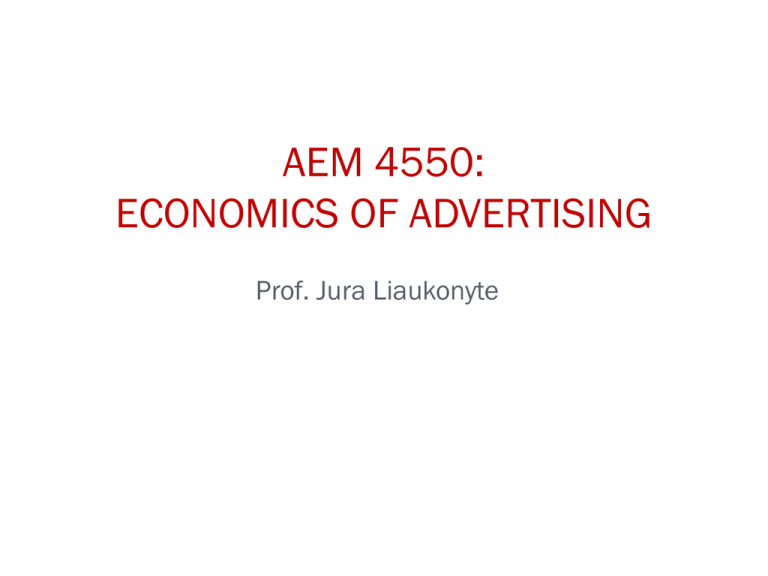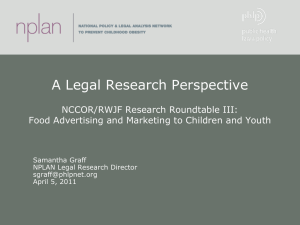
AEM 4550:
ECONOMICS OF ADVERTISING
Prof. Jura Liaukonyte
My Research
Mostly focusing on quantitative analysis of Advertising
Comparative Advertising
Motivation
Product Positions in Characteristics Space
What could advertising do to change these positions? Are
perceived and real characteristics the same thing?
My Teaching
AEM 4160: Strategic Pricing
AEM 4550: Economics of Advertising
Myths and Truths about Advertising
1. Advertising is a powerful force that usually
increases brand and product sales.
MYTH OR TRUTH?
2. Advertising’s effects persist for
decades.
MYTH OR TRUTH?
3. Advertising’s effects are
instantaneous.
MYTH OR TRUTH?
4. If advertising is not effective right away,
repetition will ensure ultimate success.
MYTH OR TRUTH?
5. Effective ads are effective forever.
MYTH OR TRUTH?
6. Advertising tends to be profitable.
MYTH OR TRUTH?
7. The most effective ad appeal is clear
information with strong arguments.
MYTH OR TRUTH?
8. Sex sells
MYTH OR TRUTH?
9. Humor Sells
MYTH OR TRUTH?
10. For an ad to be really successful,
it has to be totally unique.
MYTH OR TRUTH?
1. Advertising is a powerful force that usually
increases brand and product sales.
MYTH OR TRUTH?
Mostly Myth
Advertising successes can be dramatic, but they
are rare.
Why?
Noise level from competitors’ campaigns is high.
Competition for scarce creative talent.
Successful appeals are quickly copied.
Example: after Apple’s 1984 Macintosh introduction, dramatic
creative techniques became de riguer for new product intro ads.
2. Advertising’s effects persist for
decades.
MYTH OR TRUTH?
Myth.
Hysteresis: when the effects of advertising persist long after
the duration of the campaign.
Hysteresis: extremely rare.
Examples:
Apple
Wendy’s: Where’s the Beef?
3. Advertising’s effects are
instantaneous
MYTH OR TRUTH?
Myth.
Advertising carryover: effects of advertising at time t that are
not realized until time t+1 or later.
Very, very common. Why?
Takes time to convince; WOM; distribution; shopping trips.
Carryover tends to be short. Weeks or months, not years.
Advertising Goodwill
The effect of advertising on sales is often largely depreciated
within a year (if not less).
Latest studies: beyond 3 months = miniscule effect
4. If advertising is not effective right away,
repetition will ensure ultimate success.
MYTH OR TRUTH?
Myth.
Advertising is effective either early on, or never.
Some managers believe that advertising needs time to work
itself into consumers’ subconscious.
In fact, research shows that if advertising does not produce
any positive results in the short run, it is unlikely to ever do so.
5. Effective ads are effective forever.
MYTH OR TRUTH?
Myth.
Wearin: the amount of time or the number of exposures
required for consumers to accept and understand an ad’s
message
Wearout: the amount of time or the number of exposures
before consumers get tired of an ad
Every ad wears in and wears out
Wearin tends to be rapid
Wearout varies across people and ads
6. Advertising tends to be profitable.
MYTH OR TRUTH?
Myth
Fact: Companies often persist with ineffective
ads.
Research: average sales elasticity of advertising
is 0.1 (!!!)
Why?
Prisoner’s Dilemma
Failure to define advertising success
Difficulty in measuring advertising success
Agencies’, executives’ incentives
Other reasons…
Advertising Elasticity
Measures the sensitivity of demand given a change in
advertising
E adv
% Q
% A
Q
A
A Q
Combative advertising
Combative advertising, a characteristic of mature markets, is
defined as advertising that shifts consumer preferences
towards the advertising firm, but does not expand the
category demand.
Basis of Prisoner’s Dilemma in advertising.
Cigarette Advertising on TV
All US tobacco companies advertised heavily
on TV
1964
Surgeon General issues official warning
Cigarette smoking may be hazardous
Cigarette companies fear lawsuits
Government may recover healthcare costs
1970
Companies strike agreement
Carry the warning label and cease TV advertising in
exchange for immunity from federal lawsuits.
Cigarette Advertising
After the 1970 agreement:
Cigarette advertising decreased by $63 million
Industry Profits rose by $91 million
7. The most effective ad appeal is clear
information with strong arguments.
MYTH OR TRUTH?
Myth.
Three most common types of ad appeals:
arguments (logical appeals)
emotion (dramatic appeals)
ex: antidrug
ex: hummer
endorsements (associative appeals) ex: gatorade, Heineken
Emotion tends to be most effective. Why?
More interesting
Require less concentration
More vivid, easily remembered
Harder to counterargue
Lead more directly to action
8. Sex sells
MYTH OR TRUTH?
Usually true.
Sex certainly breaks through the clutter.
Using sex is risky:
Sex can engender negative reactions in many consumers.
Risk can be mitigated through effective targeting
When does sex sell?
When it’s appropriate to the product or category
When it helps establish the brand image
It can help break through the clutter.
There’s not much good research on sex.
9. Humor Sells
MYTH OR TRUTH?
True.
Ex: Bud
How does humor help?
Positive framing lowers resistance
Distracts an audience from counterarguments
Helps attract attention
Combines with nearly every form of persuasion (we’ll get into this
later)
Quick to the point
10. For an ad to be really successful,
it has to be totally unique.
MYTH OR TRUTH?
Myth.
Research has shown that use of templates in
advertising can be very effective.
Persuasion is a complex process. Templates
have been developed to maximize consumer
acceptance of a message.
Ads that break completely with tradition risk
ignoring scientific knowledge about persuasion.
Uniqueness certainly helps draw attention, but
does not guarantee a successful creative.









